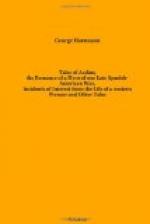There is no furniture such as we use in a typical Spanish dwelling, no bedsteads, tables, or chairs. The inmates squat on divans arranged on the floor around the walls of the rooms, and at nighttime they spread their bedding on the floors. Some of the rooms were nicely carpeted with Mexican rugs. My horse must have thought he had come to a suite of stables, for he acted accordingly. He nosed around after grain and hay, whinnied and pawed, and seemed to enjoy himself generally. At last I found the right door, came out into the street and rode to the church to tender my best wishes to the happy couple and bid them adios. When the party emerged from the chapel they seemed to be very much surprised at seeing me. I told my host that I regretted to leave them so early in the day, but had an appointment to keep elsewhere. I would ride slowly out of town so that they could overtake me easily, should they wish to see me later, but nobody came, and after several hours I caught up with my companions.
CHAPTER VIII. WITH THE NAVAJO TRIBE
After a couple of days we came to Fort Wingate, which controls the Navajo Indian Reservation. We camped here for a day to have some repair work done to our wagons, and I took a stroll over the hills after rabbits and returned to camp at nightfall. Don Juan told me that he had been visited by a number of Indians, who had bartered him some blankets and buckskins and he was highly pleased thereat.
The next morning we started early and traveled until noon. Several Indians had been following us for some time, and as soon as we made camp they squatted at our fire, while others were continually arriving, some afoot, but most of them on horseback. Manuelito, a grand-looking chief, rode into camp on the finest Indian pony I had ever seen. It was beautifully caparisoned; the saddle, bridle, and trappings were covered with silver mountings. This was by far the most gorgeously dressed Navajo I had ever met. He wore tight-fitting knickerbockers of jet-black buckskin, which resembled velvet, with a double row of silver buttons, set as close as possible on the outward seams, from top to bottom. On his legs from knee to ankle he wore homespun woolen stockings and his feet were covered by beaded moccasins of yellow, smoke-tanned buckskin. His bright red calico shirt was literally covered with silver ornaments and his ears were pierced with heavy silver rings, at least three inches in diameter. His wrists and arms were heavy with massive silver bracelets and others, carved from a stone, which resembled jade. About his neck he wore strings of wampum and glass beads, garnets, and bits of turquoise. The turquoise and garnet is found here in places known only to these Indians. His fingers were encircled by many rings, but the finest ornament he possessed was his body belt of great disks of silver, the size of tea saucers. All this jewelry was of a fair workmanship, such as is made by Navajo silversmiths out of coin silver. In fact, these Indians prefer silver to gold for purposes of personal adornment. The blanket which this Indian wore around his waist was worth at least two hundred dollars; never have I seen its equal in beauty of pattern and texture.




